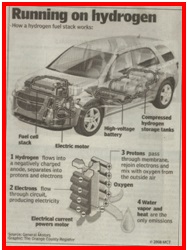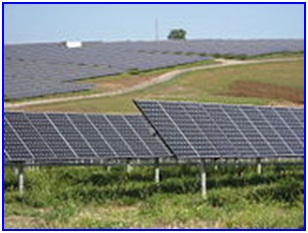
Pure hydrogen and hydrogen mixed with natural gas (HYTHANE) have been used effectively
to power automobiles. Hydrogen can be obtained from water, natural gas, coal, sewage,
coal gas etc. Hydrogen is also available as a by-product from several chemical processes,
plants or industries. Hydrogen can also be produced by thermal decomposition of
water through solar energy or nuclear power. Hydrogen has high energy content and
can be used either directly in IC engines or through fuel cells for production of
motive power and electricity. Hydrogen powered vehicles will last longer without
any pollutant gas emissions. There is no emission of Carbon dioxide and as such
this will reduce global warming trends. There is one drawback that hydrogen has
negative net energy, which means it takes more energy to produce than it contains.
FUEL CELL
A fuel cell is an electrochemical device that converts energy into electricity and
heat without combustion. Fuel cell systems generally operate on pure hydrogen and
air to produce electricity with water and heat. There are five main types of fuel
cells depending upon the nature of electrolytes i.e. alkali fuel cells, molten carbonate
fuel cells (MCFC), phosphoric acid fuel cells (PAFC), proton exchange membrane fuel
cells (PEMFC) and solid oxide fuel cells. Fuel cells produce direct current (DC)
electricity without the conventional combustion reaction. Many fuel cells are usually
assembled into a stack to produce more current.
GEOTHERMAL ENERGY

 The geothermal comes from the Greek words geo (earth) and therme (heat). So, geothermal
energy is heat from within the earth. It is clean and sustainable. It is a renewable
energy source because the water is replenished by rainfall and the heat is continuously
produced inside the earth. Geothermal energy is generated in the earth’s core; about
4000 miles below the surface. Geothermal energy can sometimes find its way to the
surface in the form of volcanoes and fumaroles (holes where volcanic gases are released),
hot springs and geysers. Geothermal energy can be harnessed for power generation,
space heating and other thermal applications. The direct use of hot water as an
energy source has been in use since ancient times specially by the Romans, Chinese
and Native Americans for bathing, cooking and heating. Geothermal power plants do
not burn fuel to generate electricity, so their emission levels are very low (less
than 1per cent of carbon dioxide).
The geothermal comes from the Greek words geo (earth) and therme (heat). So, geothermal
energy is heat from within the earth. It is clean and sustainable. It is a renewable
energy source because the water is replenished by rainfall and the heat is continuously
produced inside the earth. Geothermal energy is generated in the earth’s core; about
4000 miles below the surface. Geothermal energy can sometimes find its way to the
surface in the form of volcanoes and fumaroles (holes where volcanic gases are released),
hot springs and geysers. Geothermal energy can be harnessed for power generation,
space heating and other thermal applications. The direct use of hot water as an
energy source has been in use since ancient times specially by the Romans, Chinese
and Native Americans for bathing, cooking and heating. Geothermal power plants do
not burn fuel to generate electricity, so their emission levels are very low (less
than 1per cent of carbon dioxide).
WIND ENERGY
Wind pumps that use mechanical energy from wind primarily for water pumping purposes
are in use since long. Generation of electricity from wind was initiated at the
end of the 19th century, in 1891. Poul La Cour built the first electricity generating
wind turbine. During World War I and II it was being used to supply energy. At present
wind turbine of capacity 5 MW is in use. Global wind power grew from 4800 MW to
59, 322 MW. The statistical report prepared by the Global Wind Energy Council (GWEC)
shows that the global wind power capacity is expected to be more than double its
capacity by 2010 and one-third of world’s electricity needs by 2050. The power carried
by a mass of air that is called wind can be converted to mechanical energy by the
turbine. Wind energy is environment friendly and does not pollute the atmosphere
unlike coal fired thermal power plants. Though it appears to be eco-friendly there
are no studies on the effects of reduced wind speeds.
TIDAL ENERGY
Tidal energy is one of the oldest forms of energy used as evidence of tide mills
from before 1100 AD have been found along the coast of France, Spain and the UK.
Tides are formed by the gravitational pull of the sun and moon on the oceans of
the rotating earth. Tidal energy is the utilization of the sun and moon’s gravitational
forces. Energy can be extracted from tides by creating a reservoir or basin behind
a barrage and then passing tidal waters through turbines in the barrage to generate
electricity. France is currently the only country that has significantly harnessed
tidal energy and has the largest tidal power station in the world. India being surrounded
by sea on three sides has a high potential to harness tidal energy. In India, Gulf
of Kutchh and Gulf of Cambay in Gujarat and delta of Ganga in Sunder bans, 24 Parganas
district, West Bengal are potential sites for generating tidal power. The overall
potential of tidal energy in India is estimated at 8, 000 MW with Gulf of Cambay
accounting for over 90 per cent. Tidal energy is clean and renewable unlike fossil
fuels.
SOLAR ENERGY
 Solar energy has been used since prehistoric times, but in a most primitive manner.
When we hang out our clothes to dry in the sun, we use the energy of the sun. In
the similar manner, solar panels absorb the energy of the sun to provide heat for
cooking and for heating water. Plants use the solar light to make food. Animals
eat plants for food. Fossil fuels are in fact the solar energy stored millions and
millions of years ago. Through Solar Photovoltaic (SPV) cells, solar radiation gets
converted into DC Fig. Solar Panel electricity. This electricity can either be used
as it is or can be stored in the battery. India receives solar energy equivalent
to over 5000 trillion KWh/year, which is far more than the total energy consumption
of the country. India is one of the few countries with long days and plenty of sunshine,
especially in the Thar Desert region. On a bright sunny day, the sun provides approximately
1,000 watts of energy per square meter of the planet’s surface. One disadvantage
is that except for desert areas and rooftops of buildings solar cells cannot be
installed on a large scale. Use of solar cookers particularly in rural areas can
save a lot of fuel wood and hence the environment.
Solar energy has been used since prehistoric times, but in a most primitive manner.
When we hang out our clothes to dry in the sun, we use the energy of the sun. In
the similar manner, solar panels absorb the energy of the sun to provide heat for
cooking and for heating water. Plants use the solar light to make food. Animals
eat plants for food. Fossil fuels are in fact the solar energy stored millions and
millions of years ago. Through Solar Photovoltaic (SPV) cells, solar radiation gets
converted into DC Fig. Solar Panel electricity. This electricity can either be used
as it is or can be stored in the battery. India receives solar energy equivalent
to over 5000 trillion KWh/year, which is far more than the total energy consumption
of the country. India is one of the few countries with long days and plenty of sunshine,
especially in the Thar Desert region. On a bright sunny day, the sun provides approximately
1,000 watts of energy per square meter of the planet’s surface. One disadvantage
is that except for desert areas and rooftops of buildings solar cells cannot be
installed on a large scale. Use of solar cookers particularly in rural areas can
save a lot of fuel wood and hence the environment.
BIO FUEL
Bio fuel is defined as solid, liquid or gaseous fuel obtained from relatively recently
lifeless biological material and is different from fossil fuels.

• First generation bio fuels (bio ethanol and bio diesel) are made from sugar,
starch and vegetable oils (edible and non edible) and thus refer to those feed stocks
within the food cycle, e.g. maize grain, palm oil, rapeseed etc. using conventional
technology. Two dry land species, e.g. Pongamia pinnata, a leguminous tree; and
Jatropha curcas, a more drought tolerant shrub produce fruits containing about 35per
cent oil suitable for bio diesel. Fig.

Bio diesel Plant Bio diesel is monoalkyl ester of long chain fatty acids made by
transesterification process. Bio diesel can be used as a transportation fuel in
compression-ignition diesel engines without any modifications. Bio diesel is currently
used as 20per cent blends (B 20) with petroleum diesel. In early 2005, Gujarat became
the first state to put bio diesel to commercial use. A state-owned transport utility
began commercial service of buses that run on a diesel blend containing 5 per cent
bio diesel (B 5) from Jatropha. Shatabdi train was run from Delhi to Amritsar using
B5 (5per cent biodiesel) blend and no problem was observed during the run. Fig.
Shatabdi Express Trial Other non-edible oils like Karanja, Mahula, Neem, Kusum etc
can also be converted into biodiesel. In India it is the usual practice to produce
biodiesel from non-edible oils. Rapeseed and soybean oils are mostly used to produce
biodiesel in USA.
• Second generation bio fuels (cellulosic bio fuels) refer to feedstock produced
utilizing non-food biomass like crop residues, wild grasses based on bioconversion
techniques such as enzymatic breakdown of ligno-cellulose to make ethanol.
• Third generation bio fuels (algae fuels)


are made by bioconversion process Bio fuels have enormous environmental benefits
in comparison with conventional sources of energy, i.e. petrol and diesel. The fourfold
benefit is easing poverty, reducing air pollution, mitigating global warming and
rehabilitating wastelands. In Oct. 2005, the Union Ministry of Petroleum and Natural
Gas (MPNG), announced the bio diesel policy from Jan.2006. The Public Sector oil
marketing companies viz. Indian Oil, Hindustan Petroleum & Bharat Petroleum were
to purchase bio diesel from private operators at Rs. 26.50/litre. The purchase price
had reportedly come from estimates of the Planning Commission and twenty purchase
centers were set up in fifteen states by the oil companies. A National Bio diesel
Mission was launched by the Government of India to cover 5 lakh hectares in the
country. The Government of India has fixed a target of replacing 20percent petro-diesel
with bio diesel up to 2017 by producing 13.38 MT of bio diesel annually through
plantation of jatropha in 11.19 million hectares. It would generate employment in
the rural areas. The government proposes to encourage farmers and landless labourers
to plant non-edible oil seeds to boost the production of bio-diesel and bio-ethanol.
The agricultural produce would be procured by public or private processing entities
through the Minimum Support Price mechanism.
CONCLUSION

Nuclear energy has the potential of meeting a significant percentage of India’s
electricity requirements. India has developed technologies and necessary infrastructure
for its exploitation. Increase in nuclear installed capacity in India is of importance
not only for India but for the world in view of its climate change implication.”.
A renewable energy economy is desired and the next decade should become the age
of renewable energy. Private-sector support and international cooperation will be
needed for more stringent government policy initiatives. This will require programmes
to promote technology transfer, capacity building and collaborative research and
development. Innovations in renewable energy sources will allow developing countries
to leapfrog into modern and sustainable energy systems and technologies.
About the author: The author is Professor and Head, Department of Chemistry, Trident
Academy of Technology, Bhubaneswar, Odisha
E-mail : dr_senapati@yahoo.com